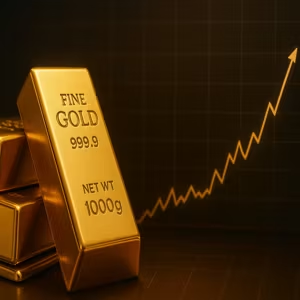Gold Climbs as CPI Inflation Opens Door for Fed Rate Cut
Posted on — Leave a commentGold climbed on the release of the September Consumer Price Index data, which came in a tad cooler than expected. Headline inflation increased 3% from a year ago, which is slightly below Wall Street’s expectations for a 3.1% jump. 
Wall Street interpreted the inflation data as a green light to a Federal Reserve interest rate cut at the Oct. 28-29 meeting. Wall Street traders are pricing in 97% odds of a 0.25 percent rate cut to 3.75-4.00% at the next Fed meeting, according to the CME FedWatch tool, which is bullish for gold.
Investors Buy Gold Dip After CPI Report
Gold advanced on the inflation news, climbing to $4,125.80 an ounce. After hitting a record high at $4,373 mid-month, gold pulled back slightly as short-term traders took profits. But the dip didn’t last long, and gold quickly rebounded after the CPI data. Gold’s ability to hold above the $4,000 level on the modest pullback reveals that the long-term, historic uptrend remains intact.
Minor pullbacks and corrections are normal events during long-term uptrends and gold is still up about 55% this year—cementing its status as one of 2025’s best performing asset classes.
Inflation Still Above Fed’s 2% Target Rate
While Wall Street traders saw the CPI number as a reason the Fed would go ahead with a rate cut, stubborn inflation remains well above the Fed’s target rate at 2%. Easing the Fed’s benchmark interest rate has the potential to make inflation worse—not better—which will help keep the uptrend in gold intact in the year ahead.
Why Did This Report Get Released?
Despite the government shutdown, the Bureau of Labor Statistics called back workers to help prepare the CPI report for release this month. By law, the government needs the CPI report to calculate the annual cost-of-living-adjustment for Social Security recipients. So, this CPI report is one of the few pieces of government information available during the shutdown. The government has already warned that the October CPI report is unlikely to be released on time.
Fed Rate Cut Cycles Are Positive for Gold
Looking ahead, Fed rate cut cycles are historically positive events for gold, because lowering rates reduces the opportunity cost of holding a non-yielding asset like precious metals. Rate cut cycles also boost inflation expectations and weaken the U.S. dollar—both which are also positive factors for gold.
|
Period |
Why the Fed Cut Rates |
Gold Price Increase |
|
2000-2003 |
Dot-com stock market crash, recession worries |
+43% |
|
2007-2008 |
Global Financial crisis response |
+54% |
|
2019-2021 |
Global slowdown, COVID-19 pandemic |
+26% |
Consumer Sentiment Sagged to a 5-Month Low
The University of Michigan’s October sentiment index reveals consumer confidence fell 1.5% on a monthly basis to 53.6% from September’s 55.1 reading. Notably, American’s confidence in the economy is falling, while their long-run inflation expectations are rising. American consumers expect prices to rise 3.9% over the next five to ten years, higher levels than they expected last month.
Record Breaking Rally in Gold Set to Continue Into 2026
Despite the recent modest pullback in gold, analysts believe this rally in gold can’t be stopped.
“Investors are watching gold not just as a hedge against inflation, but as a barometer for everything from central bank policy to geopolitical risk,” Morgan Stanley Metals & Mining Commodity Strategist Amy Gower said in a Oct. 22 research note. “We see further upside in gold, driven by a falling U.S. dollar, continued central bank purchases and a backdrop of uncertainty supporting demand for this safe-haven asset.”
Goldman Sachs recently bumped up their 2026 price forecast to $4,900 an ounce. Bank of America sees potential for gold to climb to $5,000 an ounce. Yardeni Research also expects gold to hit $5,000 in 2026 with the potential for it to climb to $10,000 by the end of the decade, which would mark a 146% rally over the next five years.








